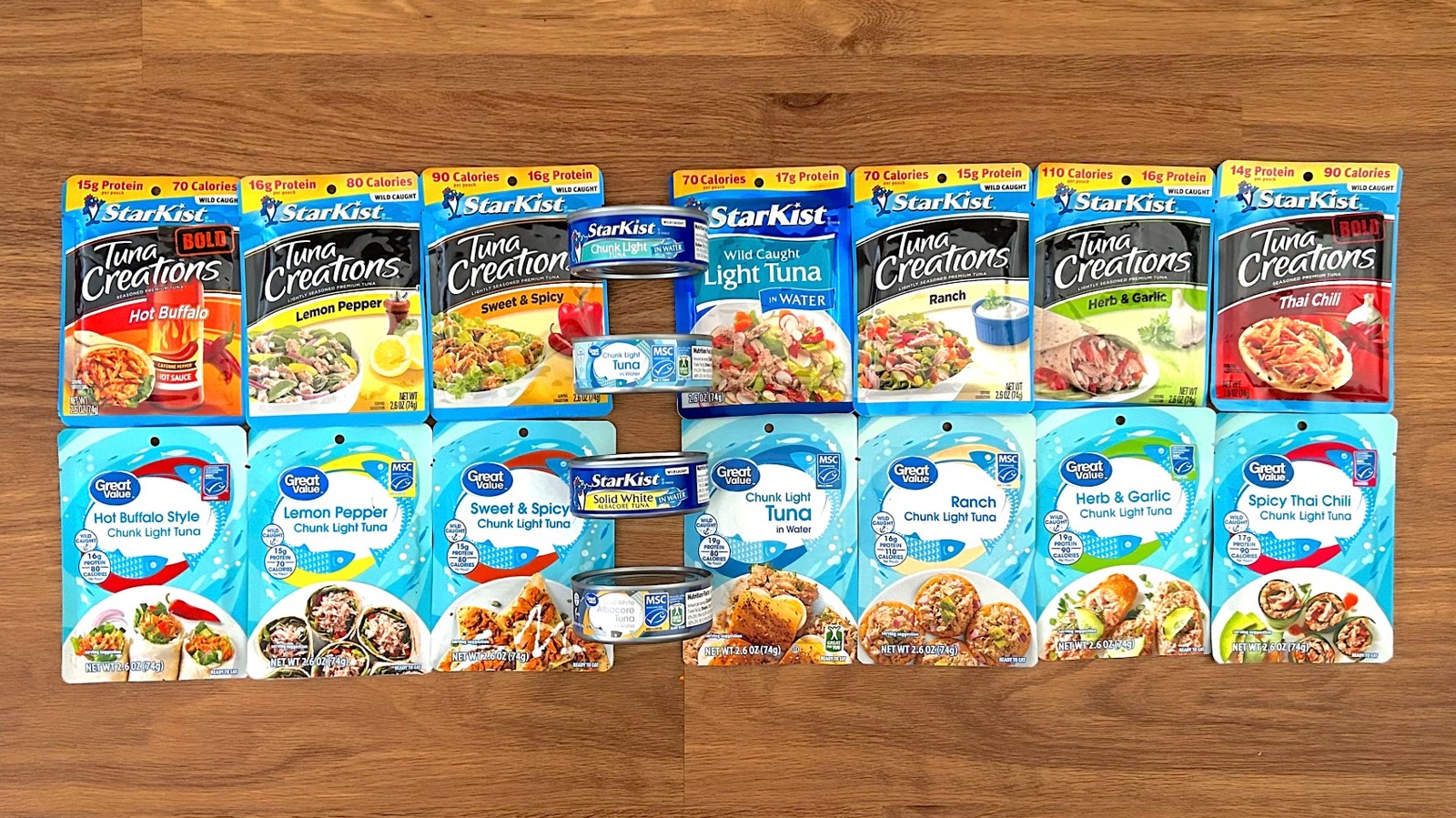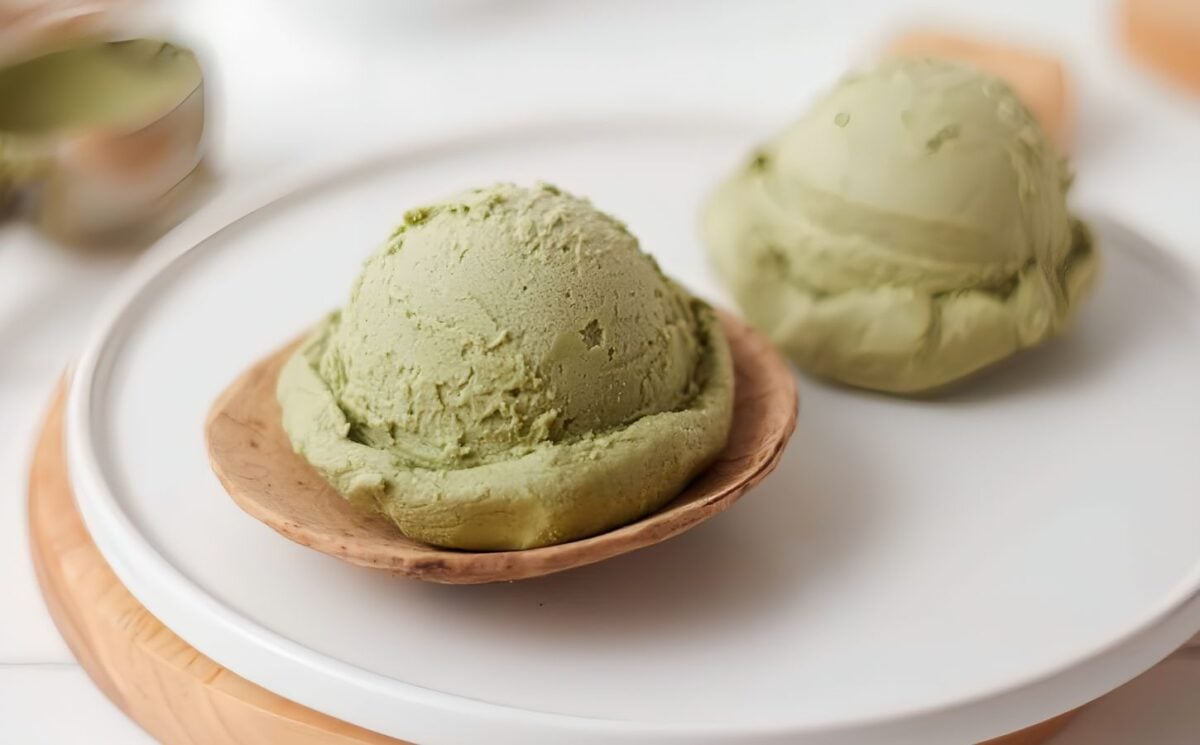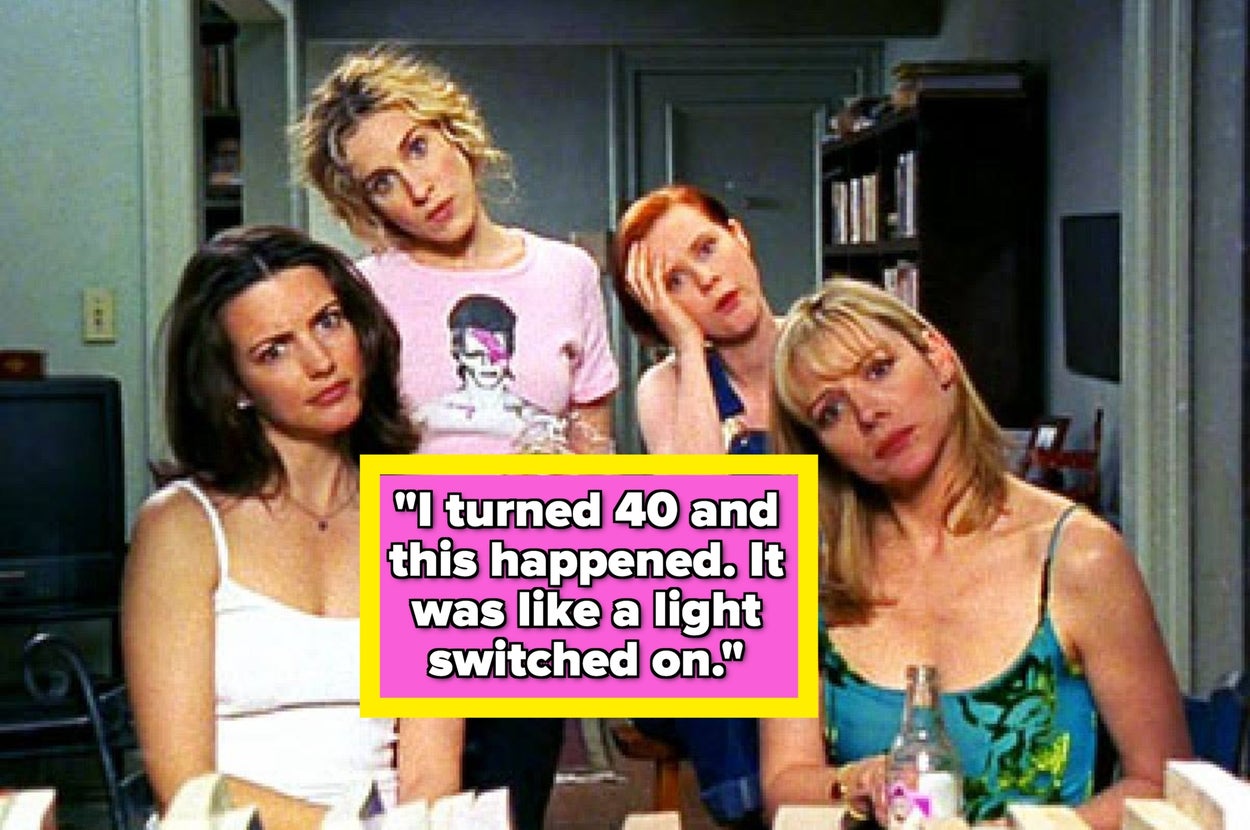Canned or pouch tuna is one of the most affordable, versatile, good-for-you, and tasty pantry items to keep on hand. While the number and types of recipes you can make from canned or pouch tuna are virtually endless, there are some considerations to be made before doing so. Perhaps the most important one is determining the variety of tuna to buy for a particular dish.
Among the more well-recognized and diverse brands of tuna on the market is StarKist. This brand has created quite a catalog of tuna creations that have given other brands a serious run for their money. One such competitor is the Walmart Great Value store-brand.

Great Value often develops similar products to directly compete with heavy-hitters in a particular market in an attempt at culling some of the market share, and it has done just that with its selection of canned and pouch tuna. In an attempt at determining which brand produced the superior canned and pouch tuna, StarKist or Great Value, I purchased a wide cross-section of similar offerings from each and sampled them side-by-side. While both StarKist and Great Value are good choices from a sustainability perspective, with the former being a member of the International Seafood Sustainability Foundation and the latter certified by the Marine Stewardship Council, they do differ in many ways, including nutritional value.
I based my evaluation of the offerings from these brands mainly on taste and texture. I suspect you will be as surprised by the results as I was. StarKist Chunk Light Tuna in Water vs Great Value Chunk Light Tuna in Water, Canned The first variety of tuna I sampled was the canned, chunk light tuna from both brands.
These five-ounce cans have some distinct nutritional differences that are worth noting. StarKist had fewer calories and less fat per can, while Great Value had less sodium and more protein. Additionally, the Great Value variety had far less water added than the StarKist one did, making it a better value.
Both the StarKist and Great Value brands of chunk light tuna had a comparable pinkish hue and a pleasant, briny, yet, not overly fishy, aroma. That's where the similarities ended. The texture of the StarKist chunk light tuna was much smaller and almost mushy in nature.
That of the Great Value variety was flaky, with noticeable chunks that looked like real fish and was far more appetizing to the eye. In terms of flavor, the Great Value tuna was slightly more salty, but had a nice meatiness that was infinitely more appealing than the StarKist tuna, which felt like it was water-logged, even after draining the tuna from the can. Overall, I give the edge to the Great Value brand on this particular variety of tuna.
Starkist Solid White Albacore Tuna vs Great Value Solid White Albacore Tuna, Canned The next variety of tuna I sampled was the canned, solid white albacore variety. Again, the nutritional values were somewhat different between the two, with StarKist having fewer calories and fat and the Great Value boasting less sodium and a higher protein content. Additionally, the StarKist variety had more water in the can than the Great Value one.
When comparing both of these to the chunk light tuna from either brand, this is a step up. Chunk light tuna is generally a combination of multiple types of tuna that are processed into smaller pieces. These can include skipjack, yellowfin, big-eye, or tongol.
These types of tuna are typically darker in color and have a stronger, more fishy taste. Albacore tuna, by contrast, is a single species with a lighter flesh that has a sweeter, less-assertive fishy flavor. This bears out with both of these brands.
The primary difference between these was in texture, which was largely attributable to the amount of water in the can. The StarKist had a much finer texture that was somewhat more juicy, while the Great Value variety was in larger pieces that were a little on the dry side. That said, I'd say this was a statistical tie flavor-wise.
These could both be used depending on the recipe, with the StarKist variety being more well-suited to a traditional tuna salad recipe , while Great Value would perform brilliantly in a croquette or casserole. StarKist Wild Caught Light Tuna in Water vs Great Value Chunk Light Tuna in Water, Pouches The third round of products I tested were the 2.6-ounce pouches of Wild Caught Light Tuna in Water from StarKist and the Chunk Light Tuna in Water from Great Value.
These varieties of tuna varied slightly in nutritional information. While StarKist still had fewer calories per pouch than the Great Value variety, with 70 versus 80 calories, the latter had less fat and sodium and more protein per serving, which gives the store-brand offering somewhat of an edge over the name-brand option. Overall, I'd say each of these pouches of tuna were vastly inferior to either the canned chunk light or albacore varieties from both brands.
I found these to be almost intolerably salty, comparatively. That said, the Great Value had more meat in the pouch and less water, which made it a little flakier in texture and gave it a less mealy mouthfeel. I also felt that the StarKist variety had a slightly odd aftertaste that was a bit off putting, which would give the edge to the Great Value brand, but just barely.
StarKist Tuna Creations Lemon Pepper vs Great Value Lemon Pepper Chunk Light Tuna The Lemon Pepper variety was the first flavored tuna I sampled from both brands. Nutritionally these 2.6-ounce packets were quite similar.
StarKist had 80 calories, 1 gram of fat, 340 milligrams of sodium, and 16 grams of protein. Great Value had 70 calories, 1 gram of fat, 300 milligrams of sodium, and a slightly lower protein content at 15 grams. The volume of meat and water level in both pouches were comparable.
The StarKist tuna had a predominantly fishy aroma, with lemon being a pleasant undertone. The flesh of the fish was quite dark in color and the meat itself was more uniformly finely flaked. The flavor of this tuna was pleasant and lemony, though I found the pepper was somewhat of an afterthought.
I also felt like the lemon taste was a bit synthetic. By contrast, the Great Value variety had a marked lemon aroma, with the fish and pepper following behind. Its meat was a lighter hue and the texture more chunky and meaty.
The flavor of this tuna was distinctly that of freshly squeezed lemons, without an ounce of artificiality. Though the pepper wasn't assertive in flavor, there was some notable heat that followed through in the aftertaste, making this brand superior overall in texture and taste. StarKist Tuna Creations Herb & Garlic vs Great Value Herb & Garlic Chunk Light Tuna The Herb & Garlic-flavored tuna was the next variety I sampled from both the StarKist and Great Value brands.
Nutritionally, the Great Value offering excelled on all fronts. It had fewer calories, less fat, lower sodium levels, and more protein than the StarKist variety for the same 2.6-ounce serving.
Because of the texture of this tuna, it was difficult to assess the moisture levels in the packets, but I'd argue that it was higher in the StarKist one. From the get-go, the aroma of these reminded me a bit of chicken noodle soup. The garlic and herbs gave them a kind of aromatic quality that was quite pleasant — saliva-producing, even.
The texture of these differed wildly, however, which in my opinion gave Great Value an immediate leg up over the StarKist. The former had a nice flaky texture that had a good mouthfeel. The latter was so mushy that it was almost paste-like, which was, quite frankly, unpleasant.
The flavor was less of a disparity, with the StarKist variety having a more robust garlic taste, while the Great Value was perhaps a bit more herbaceous, with allium notes following. Overall, I'd have to give the win to Great Value on this one. It excelled on all fronts and didn't have a strange consistency.
StarKist Tuna Creations Ranch vs Great Value Ranch Chunk Light Tuna While there are a number of different ways you can use ranch seasoning , adding it to tuna never crossed my mind, until I found these offerings from StarKist and Great Value. The nutrition facts were quite diverse between these. StarKist contained 70 calories, 1 gram of fat, 360 milligrams of sodium, and 15 grams of protein per 2.
6-ounce pouch. The comparable Great Value pouch had 110 calories, 3 grams of fat, 360 milligrams of sodium, and 17 grams of protein, which was notably higher on all fronts. Again, liquid levels were irrelevant with these tuna varieties.
The StarKist offering had a notable fish aroma, with slightly spicy notes lingering behind. The texture of this tuna was again mushy, pasty, and rather unpleasant. Its flavor was definitely reminiscent of tuna that had a packet of ranch seasoning added to it, rife with notes of garlic, herbs, and plenty of salt.
The Great Value tuna, by contrast, had a more seasoning forward aroma, with the fish being more mellow. Though the tuna itself was flaky, it looked like it was literally doused in ranch dressing from a bottle. Its flavor followed suit, with the fish being creamy, yet, somehow, still meaty.
In this case, the preference of one over the other may be simply a matter of taste. I happened to enjoy the Great Value flavor better than the StarKist one, but that is mostly because I dislike overly salty things. StarKist Tuna Creations Sweet & Spicy vs Great Value Sweet & Spicy Chunk Light Tuna The Sweet & Spicy tuna from both StarKist and Great Value were quite literally shocking from a number of perspectives.
These tuna pouches feature tuna seasoned with peppers and garlic for a sweet, yet hot, flavor that pairs beautifully with dishes requiring bold flavor, like tacos or salads. Nutritionally, these 2.6-ounce pouches were comparable, with StarKist having more calories, fat, sodium, and protein than the Great Value brand, but just.
The liquid levels in the packages were seemingly identical. The color of the StarKist offerings was more like regular tuna punctuated with peppers and spices, while that of the Great Value variety looked like the color of Cheetos. From an aroma perspective, the StarKist was a bit on the fishy side, while the Great Value dominated with a bold, spice-forward smell.
In this case, the StarKist had a nice flaky texture, while the Great Value tuna was on the pasty side. When it came to flavor, StarKist won, hands down. It had a distinctive sweet start with a spicy finish that was hot, but not desensitizing.
The taste was natural, yet rich with umami notes. The Great Value tuna excelled in heat, but was missing the sweet elements. It also had a notable synthetic aftertaste that I found quite displeasing.
Ultimately, the Great Value tuna was subpar compared with the StarKist variety. StarKist Tuna Creations Bold Thai Chili vs Great Value Spicy Thai Chili Chunk Light Tuna When it comes to bold flavor, the Thai Chili tuna offering from both StarKist and Great Value delivered in spades, though there were some notable differences that led me to prefer the latter over the former. These tuna offerings were comparable in terms of nutrients, though the StarKist did have more fat and sodium.
That said, the Great Value variety also listed quite a few allergens, which may be a dealbreaker for some, especially those who need a gluten-free option. From a looks perspective, these were virtually identical in color and texture, with no visible liquid in either pouch. The StarKist variety was a bit fishy in aroma, while the Great Value one had a delectable savory smell that was quite enticing.
The mouthfeel of these couldn't be more different, with the StarKist offering being quite mealy and the Great Value having a flakier composition. The taste of the StarKist was fine, with notable spicy and umami-rich elements coming forward. These paled, however, in comparison with the flavor-profile of the Great Value one.
This was quite complex and well-balanced, with deep layers of ginger and sesame permeating the spicy elements. I'd say the taste alone had the Great Value tuna winning by a landslide. StarKist Tuna Creations Bold Hot Buffalo vs Great Value Hot Buffalo Style Chunk Light Tuna The last tuna variety I sampled from both StarKist and Great Value was the Hot Buffalo Style option.
This tuna was exactly what you would expect — fish laced with hot buffalo sauce. Nutritionally, these tuna offerings were almost identical. The one area worth noting with both of these is sodium content.
The StarKist variety had a whopping 620 milligrams of sodium, or 27% of the recommended daily value, while the Great Value contained 630 milligrams, also 27% of the recommended daily value, per 2.6-ounce serving. This is rather high, so take note.
The best way to differentiate these two products is to say that the StarKist one felt like the tuna was barely mixed with hot buffalo sauce, while the Great Value one was thoroughly coated in it, giving the whole thing a more intense color, aroma, and flavor, even if they were comparable in elements. Additionally, the Great Value was vastly more appealing in the texture department. Yet again, the StarKist tuna was quite mushy and unpleasant, a common complaint I had about a majority of the brand's seasoned varieties.
Ultimately, Great Value won this taste test as well — and clearly, it came in first overall. How we compared StarKist with Great Value tuna When it came to evaluating the canned and pouch tuna from the StarKist and Great Value brands, I started by delving into the sustainability of each, which was comparable. I also employed my culinary spidey skills for this job, factoring in the aroma, texture, and taste of each offering to determine its overall quality.
I sampled these tuna varieties from mildest in flavor, meaning plain, to most pungent, namely the spicy ones. This enabled me to have a more discerning palate as I went through them. I tried these as-is, without bread or crackers, to have the pure unadulterated taste of each type.
As obvious as it may sound, I look for something to taste like it says it will. If the package of tuna said it should be ranch or hot buffalo-flavored, I expected it to be bold and distinctive. When it wasn't, I held that against the brand, even if the texture of the fish was pleasant and flaky, though often the two coincided.
One last note regarding the differences between canned and pouch tuna . As a general rule, canned tuna contains larger pieces of tuna than pouches, which may be preferable for certain recipes. Additionally, canned tuna is packed in water, which means you get less meat per container.
In this case, my intention of including both was to see if there was any notable variation in taste or texture between the two that might influence your purchasing decisions..
Food

StarKist Vs Great Value: Which Tuna Brand Is The Best?

StarKist and Great Value both offer an array of canned and pouched tuna products. When it comes to 1:1 comparisons of taste and texture, which brand wins?















